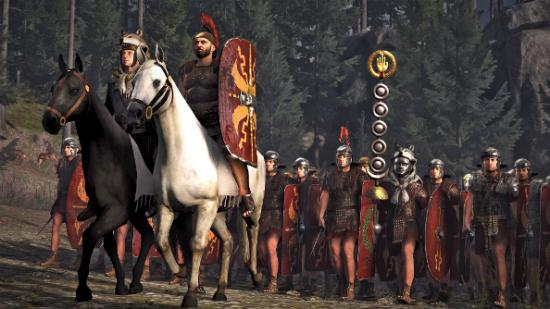The first time I saw Creative Assembly’s first foray into antiquity was not in a magazine or in a trailer, it was on the BBC show Time Commanders. The beeb were using Rome’s engine to craft historical battles for contestants to participate in, and the vast conflicts were shown in all their glory on a huge screen. It blew my tiny mind. Countless, detailed soldiers slaughtering each other amid the din of swords and spears bouncing off shields. I fell instantly in love.
Almost a decade later, playing Total War Rome II, I can feel that same shiver run down my spine as I send 5000 battlehardened Romans over the wooden walls of Bibracte, either to die or to end the threat of the painted Celts once and for all. The ground trembles at their approach, and the spears of their shrieking, howling enemies are harmlessly deflected as the men close ranks and adopt the testudo formation, snow covering their shields.
Thick towers made of oak burn, walls turn into splinters, and countless painted warriors fall to Roman steel. From afar, it’s a planned, strategic encounter, but zoomed in close, it’s all about the drama of battle. I follow the brave Roman general as he charges through the destroyed gate, enemies thrown left and right, and I hold my breath, praying that the nearby Celtic spearmen don’t engage. They don’t. I win, and it only costs 1000 lives. Roman lives, anyway.
This is Rome II at its very best: the unadulterated joy of titanic battles. It is the Rome II you’ve dreamed of playing, the very pinnacle of what Total War can and should achieve. But zoom out, beyond the action of the battlefield, and cracks start to appear.
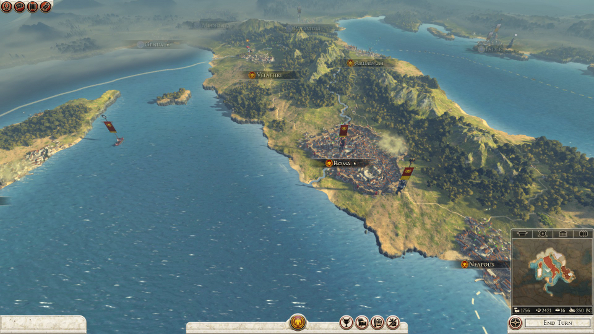
The Total War titles are split into two separate but related game modes. Real-time battles where spear and shield collide, and a campaign map where generals plan their conquest and manage their empire. The real-time battles are brutal fun, where tactical thought and clever positioning are rewarded. From the map, one’s time is split between managing armies by adding new recruits and moving them towards potential battles, and managing settlements by constructing new buildings and pandering to the plebs. A dash of international diplomacy and a spot of subterfuge tops it all off.
Rome II gives players the reins of the big names like Rome and Carthage alongside tribal powers like the Iceni or declining nations such as Ptolemaic Egypt, spreading the action throughout the classical world, with its scorching deserts, sprawling mountain ranges and gloomy forests. It’s a massive amount of geography to conquer: stretching from the Atlantic and Britain and Ireland, all the way past Arabia and the Baltic states.
2011’s Shogun II made some strides in improving the turn-based campaign, increasing the importance of the map’s geography, adding a more intricate technology tree that offered multiple routes for progression, and substantially improving the diplomacy feature. Rome II appeared to be poised to expand on this, most notably by throwing politics into the mix. But the politics of Rome 2 are shallow, and do little to improve the campaign.
Here’s how they work: larger, advanced factions such as the Romans and Carthaginians are made up of smaller factions, essentially extended families, selected at the start of a campaign. They come with unique boons and limitations, ensuring that playing as one of these empires multiple times provides a slightly different experience. The impact is not vast, but it is noticeable, with the Roman Cornelia, for example, having a harder time dealing with foreigners in their provinces than their fellow Patrician houses.
Where it starts to fall apart is in the interplay between the families. The vital resource is gravitas – your and your enemies political clout. Letting rival families increase their gravitas can end in a civil war, but there’s simply no element of risk. Players can freely assassinate political rivals at the click of a button or give the generals of opposing families gravitas reducing household characters (these characters are still player controlled, even if they are part of another family). Such acts can, in some circumstances, limit military might, especially if you choose to assassinate a general, but not to the degree that you have to wrestle with such a decision.
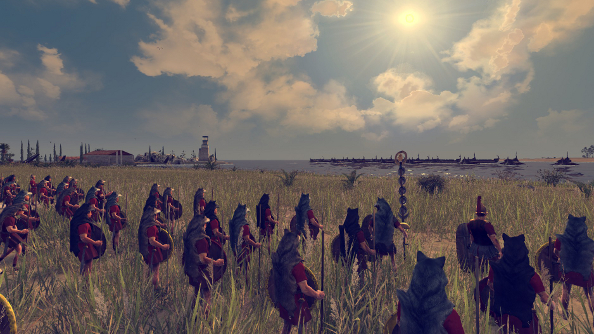
Random events crop up from time to time that affect gravitas and senatorial support. A Vestal Virgin has knocked boots with someone, a member of your family has started cutting people up — when these events occur, a decision must be made about how to proceed. Do you punish the Vestal Virgin or turn a blind eye? Do you execute your relative or hope that his grisly past time is merely a phase? The result of the decision ends with people supporting your choice or finding out about you doing something naughty, but it’s arbitrary.
Dealing with foreign factions instead of internal ones is more scintillating, but is hampered by the AI. A faction’s opinion on your own can be discerned simply by hovering over the mask that denotes their feelings towards you, which reveals a breakdown of why they feel friendly or peeved. Perhaps they don’t like treaties you have with their enemies, or they are a wee bit racist and don’t like the fact that you don’t share their culture, or maybe you just wandered into their territory last month without asking them for permission.
All of this information goes a long way to figuring out how to improve a foreign relationship, but in the end it all comes down to money and war. I know, it’s just like real life. You’re rich and they aren’t, so they’ll always try to get you to give them money. They’re at war and you’re powerful, so they want a defensive alliance. It’s shallow but logical, even if sometimes a faction will just do something that makes no sense, like continue a war they have no chance of winning, while they are at war with five other factions.
There’s another resource that also limits your options: not money or gravitas, but ‘Imperium’. It’s a measure of your power as viewed by your faction rivals. It’s increased by conquests, but it’s also an arbitrary roadblock, as it gates the number of armies you can control at any one time. In the early game, you can control three armies. It gradually, slowly, painfully increases to 6/9/and 15 armies. And it has a real impact on the game’s pacing.
It was only after spending 30+ hours in the campaign map embroiled in the conflicts of the classical world that it suddenly dawned on me: Rome II is boring for hours at a time. It doesn’t matter if you have the money and infrastructure to maintain ten armies, because if your Imperium isn’t high enough, then you are limited by three, initially. It’s a completely artificial hurdle.
It doesn’t help that the game is a slow, slow builder. Decades are spent mainly just moving armies and saving up money for buildings. Occasionally you have to dabble in tiresome politics. This tends to take all of a minute, and then it’s onto the next turn. Well, after you sit through the plodding AI turn. Eventually this gives way to a point where there are battles every turn (sometimes several) and the whole world seems to be at war, and it’s absolutely flipping glorious. The shackles are removed and the game truly becomes Total War instead of Total Wait For A Few Turns.
And here’s the rub: every addition, every sub-system, every mechanic is subservient to War. War is what Total War is really about. Everything else not directly related to conflict comes across as ancillary. Rome II is a game for warmongers, on both the campaign map and, obviously, on the battlefield. When peace is happening, nothing is happening. When war is happening, Rome comes alive.
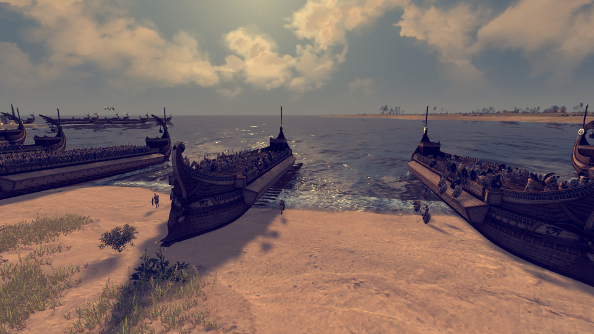
Every faction is blessed with a huge array of distinct units. Troops in the early game are bland, small in number and weak in strength, but after a few years and leaps in technology, factions churn out all manner of colourful combatants. In the east are the armoured war elephants, terrifying to behold and difficult to control; in the north, warriors charge foes on chariots, tossing surprised enemies into the air; and the Roman legions confidently stride into battle, safe in the knowledge that their heavy armour will protect them.
Conveniently, recruits are available as long as the force is in home territory. It doesn’t need to be in a settlement, nor does it need to wait for the recruits to march towards the army. The only limitation is based on the buildings in the region. A legion can’t recruit any Principes, for instance, unless the province actually has the appropriate barracks.
And choosing which units to recruit is a doddle, to boot. Hovering over the gorgeous black-figure pottery inspired unit cards reveals a short text summary, as well as a long list of the units statistics and abilities. More information, including the historical context, is a mere right click away in the large tome that is Rome II’s encyclopedia.
Military forces are more than just a bunch of fellas that can be flung at the enemy – they develop traditions. When an army or a navy levels up, it gains a tradition slot. Increased melee ability, a bonus when charging, better morale – there’s a significant number of traditions to choose from, and all of them can be upgraded in lieu of selecting a brand new tradition.
This should have made the loss of a force with many victories behind it tragic. Imagine, a legion with a decade of experience, countless victorious battles behind it, wiped out by a strategic error. Such heightened risk would make every battle count. Unfortunately, imagining it is all you can do, because another, new legion can simply carry on the destroyed one’s traditions. This suddenly makes the feature very mechanical, removing any emotional connection towards an army. They go back to being faceless soldiers, albeit ones that can be customised.

No troops can be raised without a general or admiral to lead them, and like the legions and ships they command, they develop characteristics as they travel and fight. Some traits just develop over time, like one of my commanders’ love for the Greeks, gained when he ran one of my newly conquered Hellenistic settlements. This resulted in a diplomatic bonus against foreigners and, probably, an abiding love for olive oil. Others can be selected when a commander levels up, giving them boosts to different combat or administrative abilities.
Commanders also get a household that follows them around, giving them even more buffs. Unlike the retainers found in Shogun II, these characters all go into a pool accessible by any commander at any time. Only when they are being used are they not available to another commander. Not that this is an issue when most of the household members confer the same benefits. It is, admittedly more convenient, but makes the characters simple throwaway bonus cards rather than important individuals who stick with their commander.
Agents, special non-combat units that can assassinate enemy commanders, transform the culture of a region (making it more accepting of your empire’s occupation) and impede troop movements also gets traits and bonuses in the same way as armies and their leaders. These agents can be rather helpful, halting an enemy force from marching on one of your cities, giving you time to reinforce it, or killing a particularly talented general just as he’s about to besiege a weak town.
On easy or normal difficulties, the boons earned by your armies and their commanders make little difference, unfortunately. The enemy AI is clueless, wandering around with tiny, poorly constructed armies, declaring war and never following through, or attempting to attack well-defended settlements with 70, admittedly angry, men. Strategy and tactics fly out the window, as even the occasional massive enemy force can easily be wiped out by simply remembering the “rock, paper, scissors” rules of Total War combat.
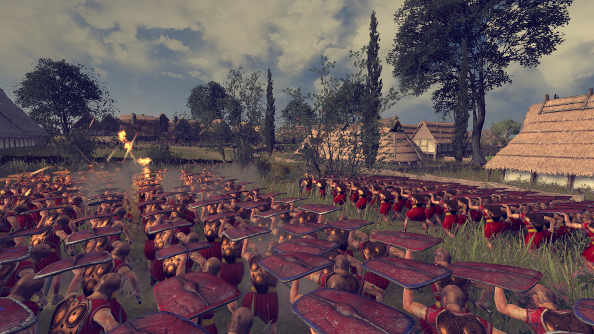
The harder difficulties present a slightly more interesting challenge. Units suddenly learn to flank, armies lay ambushes, and enemies won’t consistently fall for cheap tricks like baiting them with a single unit while your countless legions lie in wait in a forest.
It is here where the plethora of tactical options available to players start to pay dividends. Units can be grouped together, with heavily armoured spearmen protecting ranged units from cavalry charges, for example, and then ordered to defend particular areas, and there are a slew of formations and special abilities – like the aforementioned testudo formation – that can make the difference between a stunning victory or an embarrassing defeat. Geography is more important than ever, too, having a drastic impact on line of sight. Even a slight dip in the landscape can hide an army, and every forest becomes a potential trap.
It is unfortunate, then, that even on “hard”, enemy AI lacks any real creativity. Sure, it’s more aggressive and expansionist, fielding larger armies and using a better range of units, but silly decisions are a dime a dozen. It’s awful at dealing with sieges, for instance, often just letting the them finish rather than trying to break them, even when they have a huge garrison, or, even more ridiculously, when they have another army right next to the city. Legendary difficulty can and will break players, though.
Even though the pathfinding issues that seem to be part and parcel of Total War games continue in Rome II – it’s especially noticeable in sieges when units will split up entirely when they become confused when ordered to scale a wall or somehow find the longest route possible – I’ve never experienced the level of control that I’ve been able to enjoy in this latest iteration.
Despite the AI, battles are still impressive. Gargantuan naval and land assaults on fortified cities must be seen to be believed. Thousands of men leaping out of ships and onto beaches, or colliding with enemy vessels and then boarding them; yelling soldiers pushing huge ladders up to towering stone walls, and scrambling up them to duel with waiting swordsmen; siege weapons pounding on gates and smashing towers, leaving the ground pockmarked with craters – there’s nothing else that even comes close to this sort of scale.
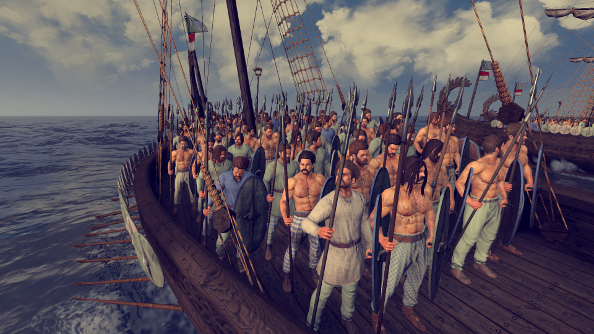
It’s not just the formations and unit abilities, the tactical view, which pulls the camera out and displays units as coloured blocks – though simple – makes deciphering even the largest battles relatively painless. At a glance, one can tell where a unit is heading and what resistance it will encounter without dealing with the mess of arrows, fire, smoke and dying men that obscure the view of the battle.
Keeping the hungry war machine ticking are the settlements and provincial capitals dotted all across the picturesque landscape. Each province is split up into smaller settlements lacking fortifications, and the larger capital. These towns generate the income and research that empires require for their bloodthirsty expansion, depending on what buildings are constructed. How much can be built is limited by population size, and once there’s a population surplus, a new plot of land can be developed, and new buildings can be ordered, rising out of the ground like the clockwork cities from the Game of Thrones opening credits.
A bit of thought goes into maintaining these settlements, as one needs to find a balance between constructing the buildings needed by the military or for a stable economy with those that will placate the population. You see, citizens are only ever one step away from rioting. They don’t like the squalor generated by industry or larger cities, they don’t like lots of slaves, they don’t like foreigners, they basically don’t like anything. So do you build that new military camp and hope that keeping a legion nearby will pacify rebellion citizens and slaves, or do you spend money on a new temple to promote public order? Actually, the answer is apparently “don’t make them pay tax”, because that seems to solve almost everything.
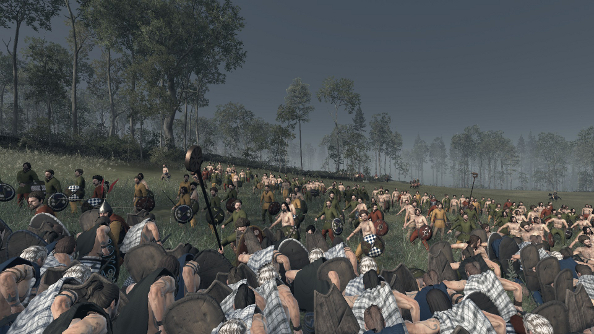
Rome II has big sandals to fill, being a sequel to what is probably the most beloved title in the series as well as following up the most proficient instalment. Lamentably, it has some rather misshapen feet. For every victory, like the scale of the combat and greater control over units, there’s a failure, like the poor AI or the flabby, pointless political system. There’s enjoyment to be found, moments of greatness even, but it’s more Varro than Caesar.
Just as Hannibal ended up running back to Carthage, to be defeated by the Romans at Zama, Rome II may well be elevated by post-release fixes. Rome II needs work: it needs a rapid acceleration of pace, some hard decisions on what limiting a player’s armies actually means, and some changes in how easy and normal modes should actually play. It hurts to say it, but Rome II is not the game we’d like it to be. But it really could be, if the developers understand and react to the problem’s with the game’s pace.
Despite the faults, I’m not going to stop playing. I know I’ll be going back to to my campaigns. In fact, I’ll likely be playing it later today, as I have some stampeding war elephants to send to war. And when they crush the dastardly rebels underfoot, as I know they will, I’ll still get that shiver down my spine, just as I did when I watched Time Commanders almost a decade ago.
